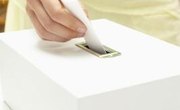Surveys and experiments are both ways to scientifically find out information about groups of individuals and how certain variables affect them. However, these two scientific procedures differ in their definitions, who or what they represent, the method used to gain results and the problems inherent in each method.
Definition
A "survey" is defined as the act of taking a comprehensive view of a situation, group or area of study. An "experiment" is defined as a test, trial or procedure used to discover something unknown. With a survey, you look at how a variable you had no control over has affected something such as a group. With an experiment, a variable is manipulated while another variable is measured.
Group Represented
In a survey, you use a representative sample to gain information about a target population. A "representative sample" is a group, usually of people, that reflects a larger group, the target population, which is the survey creator has chosen to study.
In an experiment, you use a narrowly defined group, such as a random sample, to eliminate certain variables that are not being tested.
Method
A survey usually consists of some kind of questionnaire, whether oral questions or written questions asked of the representative sample. In an experiment, two groups are formed: the experimental group and the control group. The experimental group is the one in which an independent variable is manipulated. The control group does not receive the independent variable. The dependent variable -- the result of manipulating the independent variable -- is measured and recorded for both the experimental and control groups.
Problems
Both surveys and experiments have potential problems. With surveys, it can be very difficult to obtain a representative sample that meets all the criteria of the group you're researching. You can also run into problems because individuals may not be open and honest when answering survey questions. Surveys make it difficult to obtain in-depth responses because surveys usually consist of set questions asked of everyone in the group. Possible problems with an experiment include the trial not really testing what was intended or other variables causing results rather than the variable being tested.
Related Articles
References
Writer Bio
Lindsey Fisher began writing professionally in 2010. Fisher has been published in the online magazine “Domestic Driver.” She graduated from Colorado State University with a Bachelor of Arts in journalism and technical communications with a minor in sociology.











